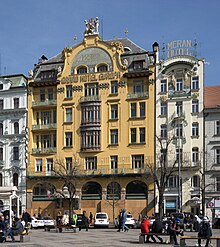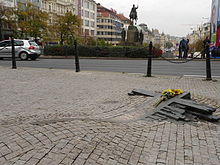Wenceslas Square
| Wenceslas Square | |
|---|---|
| Square in Prague | |
 View from the National Museum towards Můstek |
|
| Basic data | |
| place | Prague |
| District | Prague New Town |
| Created | 14th Century |
| Newly designed | in the 19th century and from 1980 |
| use | |
| User groups | Motor vehicles , public transport , pedestrian traffic , bicycle traffic , |
| Technical specifications | |
| Square area | 45,000 m² |
The Wenceslas Square (tschech. ) in the center of Prague was named after the saint in 1848 Wenzel of Bohemia named after it in the Middle Ages and the modern era as Rossmarkt the center of (Koňský trh) New Town was formed. The width of about 60 m corresponds by definition to a boulevard rather than a square . With a length of around 750 m, it is one of the largest urban squares in Europe .
history
The creation of the square in the Middle Ages
With the establishment of the New Town of Prague in 1348 under King Charles IV , a new market was created along an existing path exactly at right angles to the market in Gallusstadt as an independent part of Prague's old town , where horse trading was carried out and which was therefore called the Rossmarkt. The actual Rossmarkt was initially connected to the expansion through the St. Gallus Gate on Brückl (Na Můstku). The walled-up Gallus Gate was discovered during archaeological investigations in the back wing of the Old Town Mayor's house (Staroměstska rychta) at Rytířská ul. 12 / CN 404. It was the only one of the thirteen gates to remain in the old town. Remnants of the small stone bridge over the city moat in front of the gate were excavated during the construction of the Můstek metro station and made visible in the entrance area.
The St. Gallus Gate was closed when the Neustadt was built or a little later and replaced by a new, wider wall breakthrough that lay in the axis of the Rossmarkt. With a length of around 680 meters - due to the filling of the moat at the lower end, it is almost 750 m today - and 60 m wide, the market stretched in a north-west-south-east direction from the gate of the old town to the gate of the new town, the Rosstor (Koňská brána) or St. Prokop's Gate. Next to the gate, a small stream was also led to the market, the water of which was needed for horse drinks and at least one horse pond. The extraordinary length of the market is related to its function, because it made it possible for the animals to be demonstrated in every gait during the weekly horse market. Later grain was traded in the upper part of the market and cloth and weapons in the lower part.
In the lower part there was previously the Carmelite monastery (Klášter Panny Marie Sněžné) with the Church of St. Mary of the Snow , the cornerstone of which Charles IV himself laid in September 1347 to commemorate his coronation as King of Bohemia .
Almost exactly at right angles from the square there is a 23 m wide street that connects it with the two other markets in Neustadt. Heinrichsgasse (Jindřišská ulice) leads to the lower New Town and Vodičkagasse (Vodičkova ulice) to the upper one. This results in the shape of a cross with the Rossmarkt as a longitudinal bar and the two streets as arms. At the end of the two streets, the Neustädter Rathaus and the Heinrichskirche each have an urban dominant feature at approximately the same distance from the Rossmarkt. During official celebrations, the councilors of the Neustadt had to walk through these streets in order to be able to attend the service in the main parish church. With the addition of the tower at Neustädter Rathaus in the years 1452-1456 and the construction of the free-standing bell tower of Heinrichskirche 1472-76, this cross shape was emphasized even more.
Wenceslas Square from the 17th to the end of the 19th century
The Rossmarkt divided the newly emerging city into the lower, north in the plain, and the upper Neustadt, which was built mainly on hill country. The first structural extensions were made in the 17th and 18th centuries, a stone statue in honor of the patron saint of the square, made by the sculptor Johann Georg Bendl (1610–1680), was placed in the center of the square. This first Wenceslas monument was probably moved to a new location in Vyšehrad Castle in 1879 .
The quarters to the left and right of the Rossmarkt remain the same to this day due to their largely right-angled, market-oriented layout. But while the northern streets could be laid out exactly perpendicular or parallel to the market, those on the southern side deviate somewhat from this scheme in order to maintain the connection to the 45 ° rotated street layout of the upper new town.
In the 19th century, the market underwent a major change with the demolition of the two city walls and the filling of the trenches at its upper and lower ends and was transformed into today's boulevard by planting linden trees. In place of the St. Prokops Gate , which was demolished in 1875 , the city administration had the National Museum built in neo-Renaissance style for the National Museum, which was founded in 1818 and forms the upper structural end of the square, from 1885 to 1890 .
Urban expansion from the 20th century
Between around 1890 and 1930, the square was essentially given its current development. Numerous citizen palaces such as the Palac Koruna (number 1), the house Diamant (number 3), the Lindt house (number 4), the hotel Ambassador (number 5), the shoe store (number 6), the house to the golden goose (number 7), the Peterka House (number 12), Hotel Tatran (number 22), Hotel Sroubek (today Hotel Europa ) (number 25), Hotel Adria (number 26), the Bohemian Bank (number 32), the Wiehl house (Number 34), the Melantrich House (number 36), the Palac Letka (number 41), the house of the Böhmische Sparkasse (number 42) or the Palac Fénix (number 56) were built during this time. Between the commercial buildings, variously designed residential buildings were inserted in a closed street front . - As a means of local transport in the 20th century, the square received numerous tram lines.
Even after the Second World War , other buildings were erected, such as the Haus der Mode (number 58), the Hotel Yalta (number 45), a grocery store (number 59) or the friendship store (number 21). From 1990 onwards, the previous owners often got their buildings back and now, after extensive renovation, use them themselves or have rented them out.
January 16, 1969
On January 16, 1969 , the Czechoslovak student Jan Palach burned himself to death and ran from the National Museum to Wenceslas Square in flames. He protested against the invasion of the Warsaw Pact troops into Czechoslovakia in 1968 and the resulting suppression of the Prague Spring . Today a memorial at the place below the Wenceslas statue reminds of Palach. The actual place of the action is on the roadway, so the monument is offset by a few meters. - The following month Jan Zajíc repeated this public protest in the same place.
The Velvet Revolution on Wenceslas Square
Václav Havel and Alexander Dubček spoke at a mass rally on November 24, 1989 in Wenceslas Square and called for the whole country to be politically transformed. The call came from the balcony of house number 56. A few weeks later the Velvet Revolution was complete and communism in Czechoslovakia was history.
After Havel's death in December 2011, thousands of people mourned on Wenceslas Square.
Wenceslas Square is a frequent site of demonstrations and commemorative events even today.
Sights along the boulevard
- In 1912 the Czech artist Josef V. Myslbek created the Wenceslas Monument (Pomník svatého Václava). It shows Saint Wenceslas as the patron saint of the country in armor with armor and lance and at his feet the four patron saints Ludmilla and Prokop (front) and Anežka ( Agnes ) and Vojtěch ( Adalbert ) (back). The ornamental decoration of the monument comes from Celda Klouček (1855–1935), the architectural design by Alois Dryák .
In the past, numerous demonstrations took place at the Wenceslas Monument when it came to state independence. - The buildings named above in detail follow the architectural styles current at the time, such as Art Nouveau , Constructivism or Neo-Renaissance . Parts of earlier houses from Gothic or Baroque times were also integrated into the new buildings. Architects who realized their designs here were u. a. A. Pfeiffer, F. Buldra, F. Weir and R. Klenka, L. Kysela or M. Blecha. Several buildings were redesigned in the 1930s.
- After the closure of the tram lines, which ran completely through the street, on December 13, 1980, the north-eastern central reservation was landscaped. A discarded historic tram stands roughly in the middle of the square and is used as a café.
traffic
At both ends of Wenceslas Square there are two transfer stations for the Prague metro, Muzeum and Můstek . In addition, four tram lines cross the square about halfway up. Driving with motor vehicles is permitted, there is an access road along the National Museum.
literature
- Michael Flegl: Prague , Olympia travel guide, Olympia-Verlag, Prague, 1988, reg. 322 356 2
Web links
Individual evidence
Coordinates: 50 ° 4 ′ 55 " N , 14 ° 25 ′ 37" E







